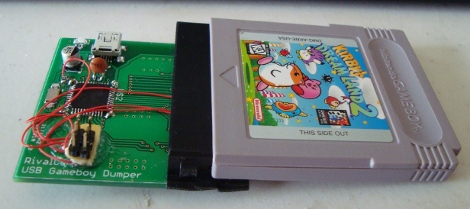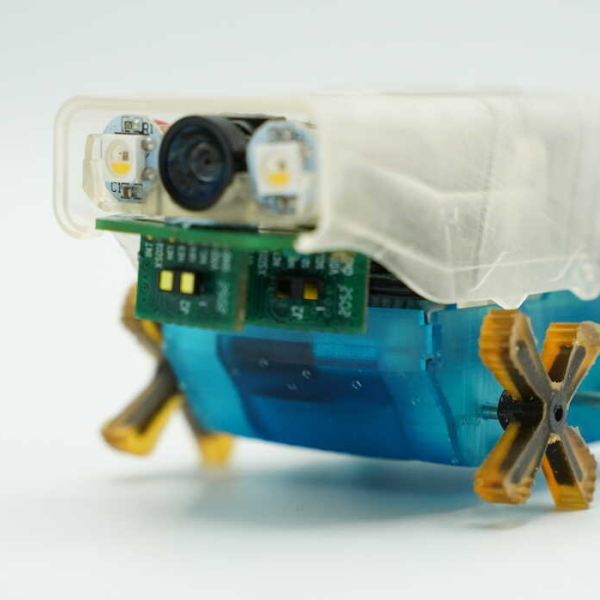
[Kevan] has been hard at work latley developing a Gameboy cart dumper, and while there are a few loose ends to tie up, the device is functioning fine to build up his collection. Running an AVR (mega 16?) and a FTDI chip for the usb connection, the device reads the game’s ROM and SRAM, and can also write the SRAM if you want to load your save games on to the real cart.
On the pc side of things, the device is communicated with using a generic HID protocol and can hit speeds from 16Kbps (currently) to around 64Kbps (soon). A python script currently handles the data stream, but for the rest of us there is a GUI version in the works for both *x and windows.
Also in the works is a redesigned PCB. There were a couple issues and you can see the jumpers, and though we think it adds a little character, it would be good to have fixed in the future.
















no source? cool pictures, i guess.
I am pretty sure the AVR is either an ATMEGA32u4 or 16u4, probably the former. I don’t see any other usb chips atmel sells that have the tqfp44 package. As such there is also no ftdi chip on board.
He does say “I will also be open sourcing the project once I have everything working how I want it.”
I don’t think there’s an FTDI chip on there — he mentions that he tried to use the factory bootloader of the AVR, which makes me think he’s using a hardware-USB-enabled chip (AT90USB or similar). I also see no FTDI chip on the board, and I don’t know of any FTDI chips that use generic HID (AKA don’t need drivers), as this one apparently does. Looks pretty spiffy, it might be interesting to try out making a version with a software USB library (since I doubt the full speed of a USB AVR is necessary for this task). Also would be interesting to try to make it appear to be a USB Key or something; it’d make for easier ROM dumping. Very cool, though!
I like the fact that there’s no (silly) FTDI chip, but posing as a HID device is just wrong. In fact, these blatant abuses of the USB HID profile are far too common (lookin’ at you, Arduino!) and just need to stop. This should be a vendor-specific device (class 0xFF) or perhaps CDC (like a serial port, but that’s not quite right either.) Hardware like this needs a driver, period; the right thing to do is write a good (userspace) one that can be trivially ported to various platforms and bridged to various languages.
And consider using usbtiny or V-USB (as mrasmus pointed out.)
I think using the mass storage class would be acceptable for a driverless and high-performance approach that’s not an abuse of purpose.
It might be using V-USB and a plain Atmega with no hardware usb..
It is a ATMEGA32U4, I chose to start off with just the Generic HID diver just to verify that the hardware part of the project is working correctly. I do plan on writing a custom driver for it to speed up dumping speeds considerably.
Hi Kevan,
I’ve got a question about a friends gameboy project
https://blog.thijsalkema.de/me/blog//blog/2013/05/14/game-boy-cartridge-dumping-on-a-raspberry-pi-part-1/
Shes trying to make gameboy cartridge slots compatible with raspberry pi, and her recent progress is this;
“Hi Shushi,
Yes, the approach should work identical between Gameboy and Gameboy Color cartridges. As far as the cartridges are concerned, they are identical.
Before you get started on this, though, you should realize that my approach doesn’t come close to being able to read the cartridges in real-time. I should’ve done the math on this beforehand, but I didn’t. I2C is simply not fast enough to transfer the data in time to play in real-time. I managed to modify an emulator and launch it on the Pi reading the cartridge, but it took minutes before it showed the first splash screen. Maybe something using a couple of shift registers could be fast enough, but I haven’t looked into that.”
Do you have ideas on how to solve this or do you know of someone that could help?
Cool hack but you can buy these for under $20, fully functional.
I don’t think it’s V-USB, I don’t see a resistor from one of the data lines to the power.
So it must be one of the AVRs with USB.
I’d like to try something like this for N64 cartridges instead. I’d love to have an optical bay just have a cartridge slot, so you can just plug in a game and go. Maybe even with controller ports.
One of the many projects I might start someday.
Kuy: unfortunately, the only practical way to write userspace drivers on older versions of Windows was to make your USB hardware a HID device. So basically, you can thank Microsoft for this widespread abuse of the HID class.
REPOST…. and indeed no FTDI chip… IS HACKADAY.COM going SOFT? :D
in case you were wondering:
http://hackaday.com/2008/01/10/usb-transferer-aka-usb-gameboy-card-interface/
He mentioned in his previous post (http://www.rival-corp.com/2011/03/29/usb-gameboy-rom-dumper/) that he’s using an ATMEGA32U4.
Nice work!
This sounds like what we’re doing, except we’re doing it for the Neo Geo Pocket Color carts and Neo Geo SRAM Savemasta cards.
http://ngpc.freeplaytech.com/
We’re also including an expansion port to make it easy to extend to other systems (GameBoy, Wonderswan, NES, etc.).
Ok I updated the project and I am now using a custom class. I am now dump a 512KB game in 4 seconds, compared to the 34 seconds from before. Using LibUSB for the driver.
I just hacked into FBI database.It wasn’t as hard as I thought. It seems the forces who supposedly ‘captured’ Bin Ladin were not really looking for him at all. Anyone seeing the code?
Why is this game rated M?
@Tom
posted at 4:04
@Crimson
Your an idiot